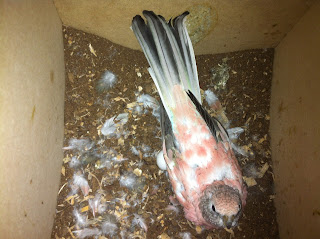I thought I best produce a timeline of nesting activity for the Indian Ringnecked Parrots
1st August - Introduced nesting box (height 43cm, width 23cm, depth 23cm) on a shelf at the rear of the aviary about two thirds from the ground and I half filled it with non toxic saw dust.
A few days after introducing the nesting box I witnessed breeding and noticed removal of some nesting material from the box.

12th August - Found the first egg in the box, this was followed by an egg every two days after until there was four by the 18th August. It was noted during this time the female "Nelly" would spend most of the day outside the box but sleep inside during the night.
5th September - In the afternoon I discovered the first egg started to hatch; I found the following morning that the hole was only slightly bigger.
 |
| Egg the following morning (6th September) |
 |
| "Nelly" with eggs (a rare sight) |
6th September - First egg hatched and it was promptly followed by the second egg the next day. I went away for the weekend leaving for two nights and when came back on the Monday afternoon the further two eggs attempted to hatch (cracked holes) but had failed and the chicks died. I have since removed the eggs from the box.

16th September - The chicks have grown well and I have handle each for the first time; the parents food intake has increased for the chicks also. It appears one will be a light colour (Albino, Creamino) and the other will be darker (Blue, Pastel Blue); this seems to be obvious by the eye colour (the older is darker and the younger has lighter eyes).
20th September - The chicks growing well and are obviously two different colours. I have been handling them the last few days (once in the morning and once in the afternoon).
 |
| Light eyes |
 |
| Dark eyes |


















































